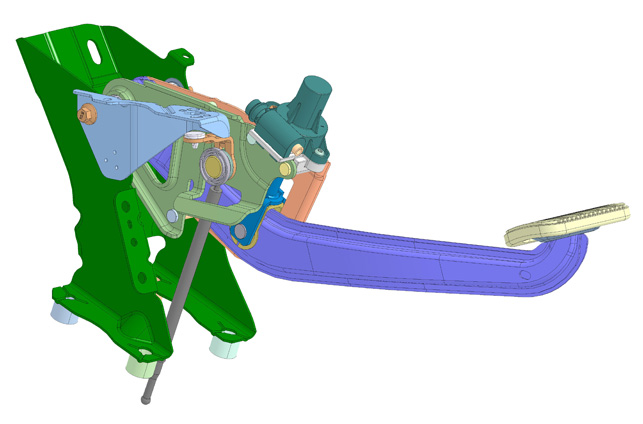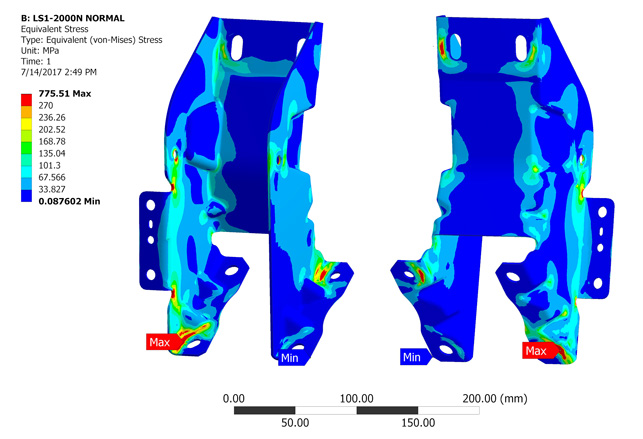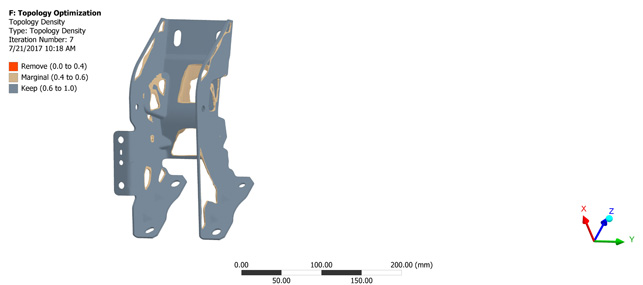
The original brake lever
The automotive industry continues its efforts to reduce vehicle fuel consumption and emissions. The most effective way to achieve both goals is to decrease vehicle weight. A 25% reduction in vehicle weight lessens fuel consumption by around 10%, while a 25% decrease in aerodynamic drag yields only about a 5% reduction.
Early efforts at cutting weight focused on the largest and heaviest assemblies, such as changing from cast iron to aluminium engine blocks. With such large weight reductions already accomplished, automobile original equipment manufacturers (OEMs) and suppliers now focus on squeezing every last unnecessary ounce out of smaller parts.
KSR International engineers used Ansys topology optimisation to largely automate the process of redesigning a brake pedal. Compared to conventional design methods, digital exploration using topology optimisation reduced structural optimisation time from seven to two days and achieved a 21% weight saving – considerably more than could have been accomplished using conventional methods.

When a driver presses the brake pedal, force transfers from pedal pad to tie rod and activates the brake boosters
Role of the brake pedal
KSR International is an industry leader in the design, engineering and manufacture of numerous automotive sensors, including accelerator pedal modules, electronic throttle control sensors, adjustable and fixed pedals, electric steering control units and power modules for automobiles, light trucks and all-terrain vehicles (ATVs).
The company makes more than 14 million fixed brake and clutch pedal modules a year.
The brake pedal is the primary driver interaction point with the braking system and must transfer all normal and abnormal loading that can occur in panic situations while remaining fully functional.
In this project, the brake pedal that was optimised is designed to withstand a pushing force exerted by the driver of more than 2,000 Newtons and significant lateral and reverse loads.
Finite element analysis with Ansys Mechanical showed low stresses in many areas of the pedal under all four load cases, which indicated the potential for weight removal.
The traditional approach to reduce the weight of the pedal was to develop new designs for simulation, either one at a time by manually defining their geometry, or dozens at a time by parametrically varying their dimensions.
Using this approach, it would take an engineer about one and a half weeks to achieve substantial weight savings by decreasing material in low-stress areas, rerunning the simulation, then modifying the design based on the simulation results. For this application, conventional methods would have been likely to achieve significant weight savings, but the final design would not be fully optimised from a weight standpoint.

Areas marked in red must be maintained during topological optimisation
Redesigning the part
The Ansys topology optimiser goes beyond incremental changes, such as adjusting the size or thickness of individual features, by essentially starting with a blank sheet of paper and designing the part from the beginning to meet objectives specified by the engineering team.
The topology optimiser is integrated with Ansys Mechanical within Ansys Workbench. KSR engineers defined the features to be maintained in the final design as the outer boundaries and mounting surfaces (where the pedal is attached to other parts) of the initial design.
They set up the simulation so that thickness throughout the part was the same as the previous design, a requirement to meet manufacturability constraints of the stamping operation used to produce the pedal. They then defined the optimisation objective as minimising the part’s weight while holding stress to a specified maximum value based on the material properties.
The Ansys topology optimiser defined a geometry for all four load cases that met the design requirements at the lowest possible weight. KSR engineers performed another structural analysis of the new design and determined that stresses were at acceptable levels throughout the part.
They also observed that stresses were very low along one edge, indicating the potential for additional weight savings.
Because these low stresses were caused by maintaining the entire outer boundary in the final part, they achieved additional weight savings by removing this boundary.

Stress analysis shows that stresses are low in most of the part
Saving weight and time
The optimised design weighs 694 grams, a reduction of 192 grams from the 886-gram original design. The new design can be implemented at no additional cost because a new stamping die must be built whenever a pedal is designed for a new model vehicle.
These improvements were achieved in only one and half days, far less time than would have been required to optimise the design using traditional methods. It should be noted that this figure refers to the time required to meet structural requirements for a specific configuration of a pedal.

The optimised design provided significant weight savings by removing material where not required
Additional time is required to package a pedal for a specific vehicle configuration. The weight savings that were achieved by using topology optimisation were much greater than those that could be achieved by changing design parameters with either manual or automated optimisation.
The automotive OEM that buys the brake pedals from KSR is very pleased with the weight savings. KSR plans to use Ansys topology optimisation in the future to achieve substantial weight savings without having to invest significant engineering resources.

Topology optimisation at KSI International
Default






